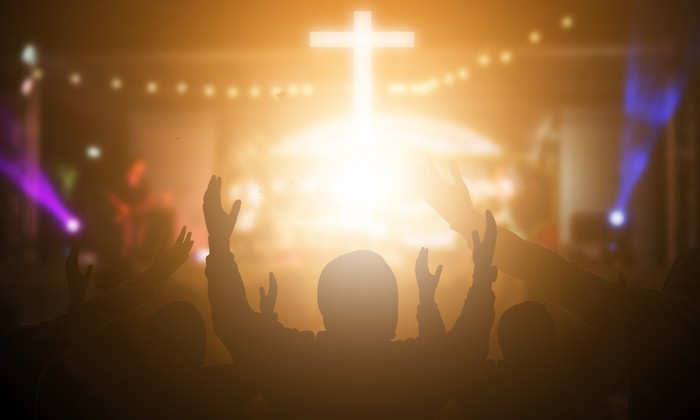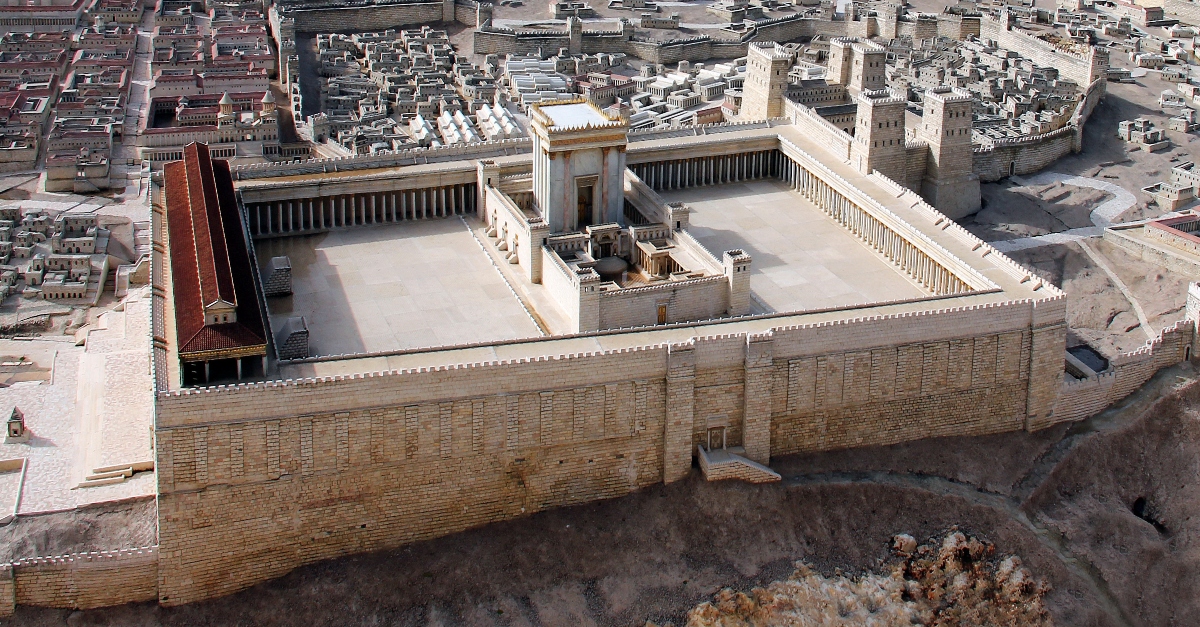
While often debated among Christians and Jews alike, Jesus and Paul are clear in their teaching.
“The time is coming when it will no longer matter whether you worship the Father on this mountain or in Jerusalem. The Father is looking for true worshippers, those that worship Him in Spirit Truth.” –Jesus in John 4:21-24
The Temple Jesus taught in was destroyed in 70 AD and was never rebuilt. For Orthodox and conservative Jews, the Temple in Jerusalem is central to their religion and coincides with their beliefs in the Messiah. The Third Temple is the one yet to be built, and many modern Jews long for it, especially since returning to the “Promised Land” after WWII.
Muslims now control that part of the city, however, and much of the Jewish homeland is disputed between Jews and Muslims. The Third Temple is much debated. But what about Christians? What does the New Testament have to say about the Third Temple?
Where Is the Third Temple in the Bible?
When Judah and Jerusalem fell to Babylon and Solomon’s Temple destroyed, Ezekiel has a vision of the Temple rebuilt in his book (Ch. 40-42). He describes the size and layout of this new Temple and explains how the glory of God comes to that Temple (Ch. 43).
In his book, Ezra builds the second Temple and restores worship in Jerusalem. However, the second Temple is not the one seen by Ezekiel in his vision. The two are vastly different. Again, the visible glory was absent at the dedication of the second Temple.
A contemporary of Ezekiel, Daniel Ch. 8 talks about the restoration of worship in Jerusalem along with an anti-Christ figure that perverts that worship. This was written before the building of the Second Temple and also has connections to the Messianic ideas in Daniel’s writings.
In the Gospels, several things happen at the second Temple. Jesus spoke of his own body as the Temple of God (John 2:19, Mark 14:58), telling the Jews that if they tore it down, He would build it again in three days, which was crazy talk to them, but Jesus was talking about His own death and resurrection. Jesus also “cleanses” the Temple, notably the Outer Court in possibly two separate events (John 2:13-16, Matthew 21). Jesus also taught regularly in the Outer Court of the Temple where all people could meet (Jew, Gentile, male, female, old, young, people with disabilities, everyone).
The only other actual, physical Temple spoken of in the New Testament is in Revelation 21 within the vision of the New Heaven and the New Earth, a place which is both a Temple and the City of God.
The short answer is that nowhere do we see a physical Third Temple being built on this Earth.
Unless we’re talking about something different. Something higher and more glorious. The New Testament does talk about that.
Is the Third Temple Literal or Symbolic?
It is neither and both.
The Old Testament prophesied of a Messiah that would be King. Was that literal or symbolic? Jesus didn’t hold an actual worldly title of King, or High Priest as Hebrews describes. Does that mean he didn’t fulfill the Davidic Messianic prophecies? Or that He’s not a Great High Priest? Of course not. On the contrary, he fulfilled those prophecies in a Kingdom of Heaven sense and enlarged the fulfillment by making it bigger and more complete. Eternal.
The Messianic prophecies were rooted in the physical line of Judah, but Jesus became a King forever in the eternal Kingdom of God. The great confession before Pilate was that His Kingdom was not of this world.
So why would we make a physical Third Temple necessary? There is plenty in the New Testament to clearly explain that the Temple Christ has built (and is building) is an eternal one in the people of God.
Jesus died and was raised again, His resurrected body shown to others, all in three days. The Church is called His Body with Jesus as the source and head of the Church (Ephesians 4:15-16). Jesus also taught in the Gospels that when someone says that God is in a specific place, they shouldn’t go. The Kingdom of God is within those that follow Jesus (Luke 17:21).
The woman at the well tried to start a religious argument with Jesus about which mountain was right to worship at (Samaria or Jerusalem), which were two different religious views and temples. Jesus’ answer? God isn’t worshipped in a place. He’s Spirit and looking for those who would worship in Spirit Truth.
When Jesus died, the veil that separated the people from the Holy of Holies was torn in two, from the top to the bottom (Matthew 27:51), signifying that the separation and division of the old system was done. Also, the Apostle Paul writes that Jesus put the Law, the Old Covenant, to death on that cross (Colossians 2:14). The Temple system was part of that covenant. We are of the New Covenant.
“House” is another word for temple, and the reborn people of God are called His house, built up together as living stones (1 Peter 2:4-6), where Jesus is also described as the Living Stone, the Cornerstone of a house that was rejected by humanity but used by God to build his “house.” We are stones, not bricks, each a different shape but made of the same material, fitted together by God.
It is common in Scripture to talk about people as types of stones. Each tribe of Israel is symbolized by jewels in the breastplate of the High Priest (Exodus 28). Jesus is now the High Priest (Hebrews 4:14-16). The apostles and prophets are spoken of as stones in the foundation of the city of God Ephesians 2:20. God’s righteous people are called jewels in Malachi 3:17.
If the Church is His House, then did he signify it with the same purpose of the Temple?
On the day of Pentecost, He marked the people of God with flames of fire (Acts 2:3, like the Tabernacle, Solomon’s Temple, and Mount Sinai in Exodus 19:18). Christians house the presence of God within them like the Holy of Holies. Where two or more are gathered together in His name, the presence of God exists (Matthew 18:20), clearly showing there is no need for a physical building.
In Revelation 21, while John is shown the New Jerusalem on the New Heaven/Earth, which is a city, garden, and Temple, a loud voice from the Throne of God says, “Look, God’s home is now among his people! He will live with them, and they will be his people. God himself will be with them. He will wipe every tear from their eyes, and there will be no more death or sorrow or crying or pain. All these things are gone forever.”
From Scripture and prophecy, from the very throne of God, we have the declaration. God’s home, his house, his city, and the temple is now with His people. He lives with them, within them even now through the indwelling Holy Spirit.
What Is the Purpose of The Temple?
To start, we must go back to the original Tabernacle built by Moses in the wilderness. Since they were traveling tribes, God had them build a tent for a place of worship, where people would meet with God, priests would perform rituals God expected from them, and the Israelites would gather as a people. The Tabernacle was supernaturally marked at its inception as God’s appointed place (Exodus 33:9).
The centerpiece of the Tabernacle was the Holy of Holies, where they placed the Ark of the Covenant that held the manifest presence of God behind a thick veil.
After the time of the Judges came the time of the Kings beginning with Saul then David. David had moved the Ark of the Covenant to Jerusalem, the new capital of Israel, and wanted to build a permanent home. God made clear He didn’t need one (2 Samuel 7), but the task was handed down to David’s son, Solomon, to build the Temple.
David gave Solomon the instructions, and Solomon built the Temple which had a structure similar to the Tabernacle in its divided sections and the Ark of the Covenant in the Holy of Holies. The Temple also served the same purpose of housing God’s presence and being the place where Israel had fellowship with God and worshipped Him. God again marked his pleasure with the Temple through a supernatural manifestation (2 Chronicles 7).
The Second Temple served the same purpose of the place to meet with God, fellowship with, and worship Him.
Much of the Old Covenant rituals require a Tabernacle or Temple to be consistent with God’s Law, referred to as the Mosaic or Old Covenant. The Third Temple would give the Jews a central location once again to worship and fully keep God’s covenant with them. For the Jews who believe that the destruction of the Temple was a punishment for their sin and rebellion, the Third Temple would be a sign of redemption in conjunction with the coming Messiah.
Photo Credit: © Getty Images/arkira

What Happened to the First Two Temples?
Solomon’s Temple was built in 1000 BC and destroyed by Babylon in 586 BC. As part of the downfall of Israel and then Judah, the Ark of the Covenant was already gone. The Old Testament doesn’t give the details of when or who took the Ark, but it was possibly stolen by the Egyptians or even Babylon.
After Babylon fell and the Persian Empire rose to power, the King of Persia allowed the Jews to return to Jerusalem to rebuild the wall and the Temple. The book of Nehemiah is the narrative of rebuilding the wall; Ezra gives the story of constructing the second Temple, which took from 538-515 BC. While there was great sorrow and rejoicing at the rebuilding of the Temple, there was no supernatural manifestation by God to put his mark on the Second Temple (Ezra 6).
The Ark was either never found or found and not restored. King Herod, a Roman political puppet, added onto the second Temple in 37 BC, enlarging it. When Jesus was born, there was no Ark of the Covenant and therefore no manifest presence of God in the Second Temple.
The Second Temple was destroyed in 70 AD during the Roman Empire. It has never been rebuilt. A single stretch of the wall remains, and people call it the Wailing Wall today because of the sadness and grief over the destruction of the Temple and the lack of a central place to worship God for the Jews.
What does this mean for us?
We are the place where people can meet God. Scripture gives us the commission to preach, to minister, to love, and to reach out to others. The mission is to go ourselves, not to invite people to a building, but to bring the Temple (the Church) to a lost and dying world by getting involved in the pain and the chaos of others.
Moses came down from the mountain with his face shining from his time in the presence of God. The people were frightened and begged him to cover his face. Which he did.
Paul, however, says that we aren’t like that. We interact in the world with “unveiled faces,” the glory of God shining from within us to bless others (2 Corinthians 3:18).
As individuals and among two or three, we bring the Christ, the anointing, to others, the very Holy of Holies to those that need to see there is a better life, an eternal life, a Father who loves them more than they ever thought possible. Amazing things happen when we live that mission.
I get it. We don’t feel very glorious most of the time. Maybe none of the time. But the Truth isn’t dependent on how we feel but in the Word of God. We were born from Heaven to give people the hope of Heaven on earth.
That’s good news. The Gospel for everyone.
Photo Credit: © Getty Images/TonyBaggett

This article is part of our larger End Times Resource Library. Learn more about the rapture, the anti-christ, bible prophecy and the tribulation with articles that explain Biblical truths. You do not need to fear or worry about the future!
Battle of Armageddon
Tribulation
Signs of the End Times
The Four Horsemen of the Apocalypse
The Seventh Seal Opened
What Is the Death Angel?
Related podcast:
The views and opinions expressed in this podcast are those of the speakers and do not necessarily reflect the views or positions of Salem Web Network and Salem Media Group.
Related video:








